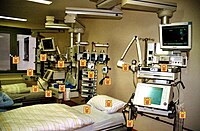
Photo from wikipedia
Abstract The prevalence of nosocomial infections (NIs) is associated with different bacteria found in hospitals. These infections in their extreme conditions result in morbidity and mortality. This study aims to… Click to show full abstract
Abstract The prevalence of nosocomial infections (NIs) is associated with different bacteria found in hospitals. These infections in their extreme conditions result in morbidity and mortality. This study aims to provide a detailed review of literary studies to identify the prevalence of nosocomial infections and antibiotic-resistance specifically in Middle Eastern countries. A literature review approach is followed in this study. It further identifies different causes and effects associated with nosocomial infections in the given regions. Relevant studies were used to extract important information, specifically related to the Middle Eastern countries. The findings indicated that nosocomial infections following antibiotic resistance are an emerging problem in Middle Eastern countries, leading to significant morbidity and mortality. Most frequently reported NIs in Middle East in our review are bloodstream infections (BSIs) (50%) and surgical site infections (SSIs) (50%) followed by urinary tract infections (UTIs). Escherichia coli and Klebsiella species among gram-negative bacteria, Staphylococcus aureus among gram-positive bacterial and fungal pathogens such as Candida species are most reported pathogens involved in nosocomial infections and resistance to penicillins, cephalosporins, carbapenems and fluoroquinolones antibiotics were significantly reported. However, most studies showed minimum resistance of pathogens against drug colistin. To control the growth rate of the given condition, government officials are suggested to ensure that hospitals follow adequate healthcare mechanisms. Also, sufficient education must be provided to the hospital staff about the causes and effects of the given disease.
Journal Title: Infection and Drug Resistance
Year Published: 2022
Link to full text (if available)
Share on Social Media: Sign Up to like & get
recommendations!